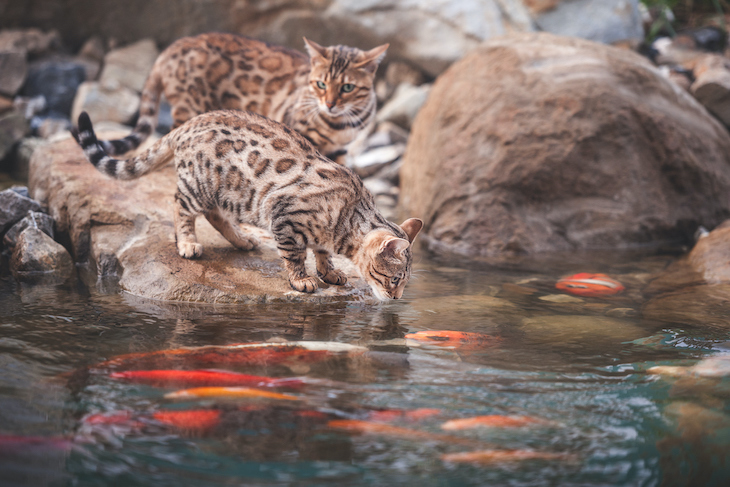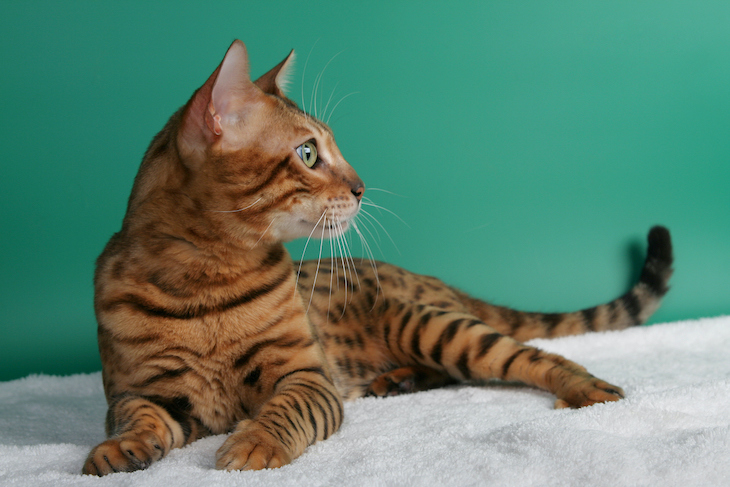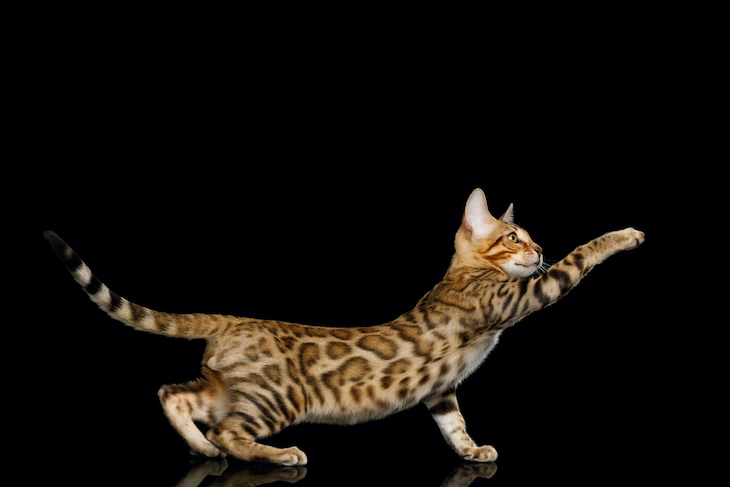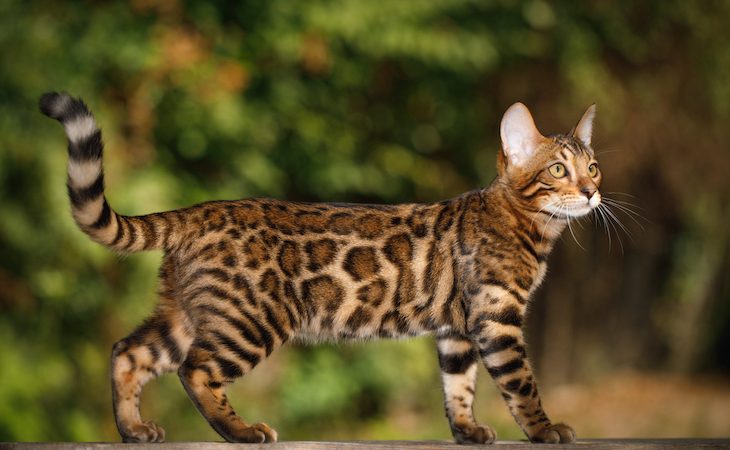Breed standard: TICA, ACFA, CFA, FIFe, GCCF I Size: Medium-large I Average Lifespan: 12-16 years I Temperament: Intelligent, energetic, affectionate I Coat: Shorthair I Origin: USA
The Bengal cat is a highly intelligent breed characterized by its wild, leopard-like appearance. It is incredibly active and playful with an affectionate and gentle temperament.
Bengal: origins of the breed
The Bengal, or ‘miniature leopard’ as it is affectionately known, is a hybrid breed resulting from a cross between a wild Asian Leopard cat and a domestic cat.
Earliest written records describe a Bengal-like breed, or Asian Leopard cat hybridization dating back to the late 1800s. These include mentions in Harrison Weir’s book Our Cats and All About Them released in 1889, as well as records from 1871 from the first organized cat show at Crystal Palace in London. This led to an increase in popularity of these exotic leopard-like cats, however, there appears to be no continuation linking them to the Bengal breed we know and love today. Instead, the Bengal came to be known much more recently.
Many recognise Jean Mill as the key creator of the Bengal breed as we know it today. She began her successful journey in 1980 when she received some hybrid wild cats from Dr. Willard Centerwall, a professor of pediatrics and maternal health at Loma Linda University Medical Center in California. Dr. Centerwall and his team had been breeding Asian Leopard Cats for the previous two decades as part of his research of immunocompromised humans; feline leukemia and human leukemia operate in a similar fashion and therefore presented an exciting opportunity for Dr. Centerwall and his team to determine if the cats’ immunity to the disease would be passed onto their hybrid offspring. While the research didn’t produce the sought after results, these new cats instead became the forerunners for those who would later be recognized as the Bengal cat.
So who was responsible for the Bengal’s development?
Fundamentally, the Bengal was bred to obtain a cat with wild-like markings, but with the disposition of a domestic cat. Jean Mill specifically wanted to create a wild-looking domestic cat in the hopes of deterring the illegal trade for their exotic wild counterparts. She also believed that people would be less likely to purchase and wear real fur if they associated a Bengal as a loving and affectionate household pet.
However, the Bengal breed was already said to have been created at least a decade earlier by a man named Bill Engle. Bill was a zookeeper and a recognized member of the Long Island Ocelot Club (LIOC). His fascination for exotic wild cats saw his very own leopard cat, named Shah, produced nine ‘Bengal’ kittens in 1970. By breeding Shah, he wanted “To create a small exotic cat that was beautiful and that had the disposition that was suitable for a pet house cat, that had a greater resistance to disease of civilization than his jungle-bred cousins, and that would readily reproduce himself.” By 1975, Bill had bred a total of 60 Bengals down 2.5 generations.
The Bengal cat is considered domesticated from the 4th generation.
Registration and continued breeding of the Bengal
What sets Jean Mill and Bill Engle apart is that Bill’s Bengals were bred just three generations down as opposed to Jean’s four generations (a Bengal is considered domesticated from the 4th generation). Today, no Bengal can be linked back to Bill’s cats despite his registering of the breed with the American Cat Fanciers Association. According to records, he registered the Bengal name which some believe stems from his name B. Engle. Others suggest the name stems from the breed’s heritage, namely felis bengalensis, the Latin name for leopard cat.
In 1983 Jean Mill successfully registered the Bengal cat with The International Cat Association (TICA). This was a big achievement and propelled her to launch a nation-wide and even global campaign to raise the profile of the Bengal cat. She encouraged breeders to breed these hybrids down the line to eventually achieve recognition of the Bengal as a domestic cat breed more broadly. Therefore, despite Dr. Centerwall’s and Bill Engle’s involvement, as well as many other wild-cat hybrid breeders including Doctors Greg and Elizabeth Kent, it was Jean Mill’s dedication to the breed that brought about its global recognition.
Character of the Bengal
The Bengal: its qualities
These impressive leopard-like cats have become one of the most popular cat breeds for homes around the world. Like the Maine Coon, the Bengal is often referred to as a ‘dog-cat’; they are full of life, character and energy, and are keen to play, swim (yes, they love water!), and learn new tricks thanks to their acute intelligence.
You should even be able to teach classic ‘dog’ training skills such as ‘sit’, ‘lie down’, ‘roll’ and ‘high-five’. Some Bengals can also do other tricks, like open doors, turn light switches on and off and even lift up bin lids. They are also sensitive to their owner’s moods and will adjust their behaviour accordingly. Bengals are very chatty and will let you know when they need or want something, and if you ignore them, they will most likely become louder.
Introducing them to other pets and children properly also won’t be a problem.
Are there any downsides to owning a Bengal?
As a relatively newer breed with few ancestors, Bengals are more prone to some hereditary conditions. These can include progressive retinal atrophy (PRA), cataracts and hypertrophic cardiomyopathy. Renal failure is another, although this is not uncommon amongst many other cat breeds.
Such conditions should all be explored prior to purchase. This means pet parents should ensure they get their Bengal from a reputable breeder with a recorded health chart spanning the litter’s predecessors.
Bengals are also very active, needing a lot of stimulation and exercise to expend their energy. Therefore a quiet, empty home environment won’t suit this breed type.

Physical characteristics of the Bengal
General appearance
It goes without saying that the Bengal’s coat is its most notable and desirable characteristic. Well-known for resembling little leopards, the base color can be speckled or marbled with different kinds of markings that decorate the coat. Some Bengals can inherit the glitter gene, which gives their coat an iridescent sheen, making it look like their fur sparkles in the sun!
Classed as a medium to large cat, Bengals can weigh up to an impressive 8kg. They have a strong and muscular body with long legs that allow them to jump high.
Zooming in on the Bengal’s head
Second to its coat, the Bengal’s wild head is perhaps one of the most distinctive elements of the breed’s appearance. It has a wild, nocturnal look about it.
The head is broad and rounded, and slightly smaller in proportion to its body. It is longer than it is wide and features high cheekbones with prominent whisker pads. There are no flat planes on the head. According to TICA’s breed standards, jowls are permitted in adult males. The overall look of the head should be vastly different to its domestic cat heritage.
Ears are small to medium in size, relatively short in height, and sit wide at the base. They also sit wide on the head following the contours of the head’s topline when viewed from the front. From the same perspective, the ears face forward. Tufts are undesirable.
The wild eyes of the Bengal are round to oval in shape and set far apart. They are large but not bugged, slanted slightly upwards towards the base of the ears. Eye color should be independent to the coat color, typically green, yellow or gold, except in the lynx points where blue is the only permissible color. Color is expected to be rich and offer depth.
The Bengal’s nose is large and wide. The bridge creates a very slight concave profile from the top of the bridge, extending above the eyes to the nose tip.
Body of the Bengal
The sleek, muscular build of the Bengal is distinct, particularly noted in the longer male physique. Legs are medium-long, with the hindlegs slightly longer again and sitting higher than the shoulders.
Paws are large and rounded and well knuckled.
The sturdy, supportive bone structure supports a long torso and a medium length tail, in proportion to the body. The tail is thick and tapered at the end with a rounded tip.

Eligibility criteria
Breeding and competing become serious business in the world of cat fanciers and, like any other breed standard, Bengals must adhere to the strict breed standards in place. Some allowances are made, while other features lead to immediate disqualification.
Allowances when competing
- Smaller sized females still in balanced proportion
- Slightly longer coat in kittens
- Jowls in adult males
- Eyes slightly almond shaped
- Mousy undercoat
- Paw pads not consistent with color group description
Features leading to disqualification
- Any distinct locket on neck, chest, abdomen, or anywhere else
- Kinked or otherwise deformed tail
- Cow hocking
- Crossed eyes
Coat, color, and grooming
Bengal coat
Bengals sport a short (or short-medium), soft, silky, luxurious, and ideally glittered coat. This is the breed’s defining feature.
The base color can be spotted or marbled. A spotted coat shows markings at random but aligned horizontally. Bengals are the only domestic cat breed that feature spots, or rosettes, like the markings on leopards, jaguars, or ocelots. These rosettes are more than one color, usually with a darker shade outlining the spot. They vary in color, including rust, cocoa, chocolate brown, charcoal, and black, as well as shape. Shapes include paw print, arrowhead, donut, or half-donut.
A strong, bold chin strap and mascara markings are highly desirable while a virtually white
underside and belly is also sought after. However, the belly must be spotted. Similarly, blotchy horizontal shoulder streaks, spotted legs and spotted or rosetted tail are desirable.
Bengal colors
There are two key categories of the Bengal’s coat color:
- Brown tabby: all variations of brown are permitted while markings are brown or black
- Seal Sepia Tabby, Seal Mink Tabby, and Seal Lynx Point Tabby: pattern can be various shades of brown, however there should be very little or no difference between the color of the body (pattern) markings and point color.
Additionally, the ‘snow tabby’ Bengal has a white or light brown pattern and appeared early on in the breed’s development when some of the domestic cats (carriers of recessive colorpoint genes) crossed with Bengals. The original variation, ‘Seal Lynx Point’ was the result of the albino gene in the Siamese genes.
Bengal grooming tips
Being a shorter-haired breed, Bengals are quite self-sufficient and maintain their own grooming standards well. They will, however, benefit from having some additional care from their owner.
A brush once per week is sufficient to allow the Bengal’s coat to flourish and shine. This will help to alleviate dead skin and any build up of fur. As a fan of water, your Bengal may not be averse to the occasional bath, so if you feel it necessary following some intense and dirty playtime, then you may wish to bathe your Bengal using only specialized Bengal or cat shampoo. Talk to your vet if you’re unsure. This said, bathing is not required.
Like all cat breeds, vaccinations, annual checks, and parasite treatments are all required.

3 things to know about the Bengal
#1. Bengals are known to love water. You can often find them playing with a dripping tap, or even following you into the bathroom when you go for a bath, shower or even to brush your teeth!
#2. The average price of a Bengal kitten is around US$1,000. This can vary from as little as US$400 and extend up to US$10,000 depending on the breeder, the pedigree and the age of the cat!
#3. Retaining their wild leopard cat ancestor traits, Bengals make excellent climbers and jumpers, and can even jump up to three times their height!
* * *
The Bengal at a glance
Size: Medium-large, with large males weighing up to 8kg. Females tend to weigh up to a maximum of 6kg.
Health: Bengals are prone to eye problems so it’s important to check their genetic history with the breeder. Heart conditions can also appear in some, while the right diet should help to minimize any kidney problems. Bengals typically live between 12 and 16 years.
Are Bengals good with children? Bengals are gentle and affectionate cats. If you have a big family with other pets, then not to worry! They get along well with both children and other animals. Their energetic, playful nature will also be ideal as a companion for younger ones.
How easy are Bengals to live with? Bengals are fun to live with. They are intelligent, curious, energetic and love attention. Taught correctly, tricks come easily to this breed and you should have yourself a mini dog-cat playmate. They will want your attention though and will demand it through vocal communication. Therefore you’ll need to be willing to dedicate love and time to your Bengal!

